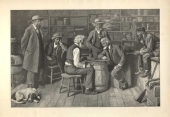The Checker Maven
The World's Most Widely Read Checkers and Draughts Publication
Bob Newell, Editor-in-Chief
Published every Saturday morning in Honolulu, Hawai`i
Noticing missing images? An explanation is here.
Publication Times
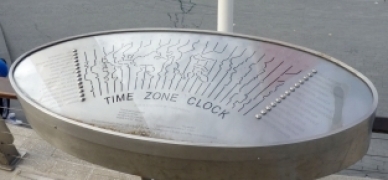
The Checker Maven originally appeared each Saturday at 2:02 AM MST (GMT-7). When our offices relocated from Santa Fe, NM, to Honolulu, HI, our publication time changed to 2:02 AM HST (GMT-10).
Now, many of our readers are on the east coast of the United States and look for the latest column early in the morning. With our present publication time, the week's offering isn't available until 8:02 AM EDT. That's later than we might like, and so effective at once we'll be moving to a publication time of 00:02 AM HST, or two hours earlier than the current publication time.
We hope this time change makes access to The Checker Maven a little more convenient for our readers.![]()
Delicado

Your editor, many years ago, went hiking and climbing in southern Mindanao in the Philippines. Locals referred to the area where we went as "delicado" --- delicate --- due to the sometime presence of rebel militia. Being young and foolish, we were not deterred from what turned out to be a dangerous undertaking. Fortunately, nothing went wrong.
Today's checker problem is "delicado" in a different way, and there's nothing foolish or dangerous about it at all. Your solution may go wrong, but if you work at it, you'll get it, and you may learn some technique in the process.
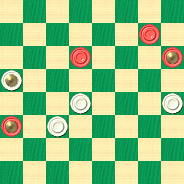
WHITE
White to Play and Draw
W:W22,20,18,K13:BK21,K12,10,8.
There's no need to carry arms or keep a lookout, and checking your solution is as easy as clicking on Read More.![]()
August Heat
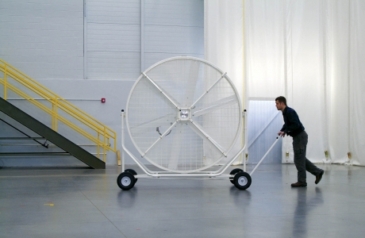
August in the Northern Hemisphere can be pretty darn hot. Sometimes extraordinary measures are required, as shown in the photo above.
Your editor is scheduled to be visiting in far off New York City on the date this column is due to be published, and August in New York is just about always hot and humid.
So we picked out a rather hot stroke problem (please, no heat stroke jokes) for this month. It looks complex but it's actually one of the easier ones, and it's filled with action.
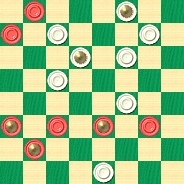
WHITE
White to Play and Win
W:W31,19,14,11,K10,8,6,K3:BK25,24,K23,22,K21,5,1.
Don't overheat your brain; you'll see the solution if you can visualize well (just keep the sweat out of your eyes). When you've solved it, click on Read More to see the solution.![]()
Brooklynite
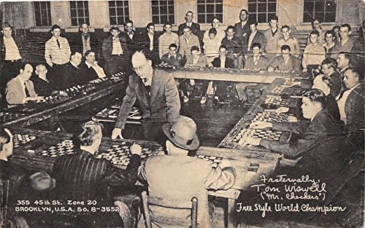
We came across this personalized postcard evidently made for checker great Tommie Wiswell. Mr. Wiswell is playing a simultaneous exhibition, as he often did. Note that the postcard lists what was apparently his home address, 355 45th Street in Brooklyn, a building that is still standing. Our research tells us it's in the Sunset Park section of Brooklyn, was built in 1910 (interestingly, the year Mr. Wiswell was born); it's listed as a multiple family dwelling; the size is about 2,500 square feet on a 2,000 square foot lot; and it's valued at around $800,000 or so.
We'll use any excuse to feature a Tommie Wiswell problem, of course. This one is based on a Louis Ginsberg game played at an unspecified club in New York City. Mr. Ginsberg was also a Brooklynite, and hence comes the title of the problem.
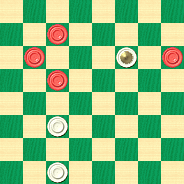
WHITE
White to Play and Draw
W:W30,22,K11:B14,12,9,6.
The problem isn't all that easy in that there are some nice ways to get it wrong. It would be a lot of fun to work on it at a nearby Brooklyn park, but in this internet age, you can solve it from just about anywhere in the world. Give it a try and then click on Read More to see the solution, notes, and an interesting photo.![]()
Capers on the Kelso: Lucky 13
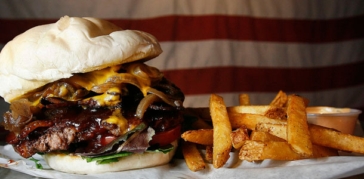
13 is viewed by some as a bit of a "shady" number but we've always liked it. For instance, how can you argue with that great-looking All-American meal above, served by the Lucky 13 Bar and Grill in Salt Lake City?
This is the 13th installment of "Capers on the Kelso" from Willie Ryan's Tricks Traps & Shots of the Checkerboard, and we think you're in luck once again. These pages in Willie's classic book contain an unbelievable wealth of great checker material. Today's position is subtle rather than explosive.
We're still working with Willie's "Variation 3" and in "Note B" of the text we find another fascinating and instructive situation.
Here's the run-up, without commentary.
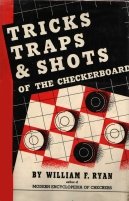
| 1. | 10-15 | 22-18 |
| 2. | 15x22 | 25x18 |
| 3. | 6-10 | 18-14 |
| 4. | 10x17 | 21x14 |
| 5. | 9x18 | 23x14 |
| 6. | 1-6 | 29-25 |
| 7. | 12-16 | 26-23 |
| 8. | 16-19 | 24x15 |
| 9. | 11x18 | 28-24 |
| 10. | 8-11 | 31-26 |
| 11. | 4-8 | 23-19 |
| 12. | 6-10 |
The correct move here was 6-9. Willie now calls this "a dead loss." Indeed, it is; but White will require patience and technique to bring home the win.
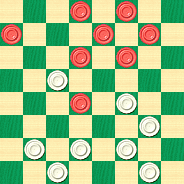
WHITE
White to Play and Win
W:W32,30,27,26,25,24,19,14:B18,11,10,8,7,5,3,2.
You don't need to be lucky to solve this one; although the solution is long, it's not nearly as difficult as some of the others in this series. Try your luck; then, for sure you'll luck out when you click your mouse on Read More to see the solution.![]()
Are You Dunne Drummond Yet?
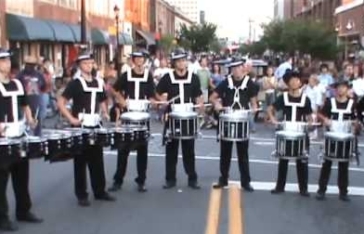
We think you'll agree, when you work through this week's Checker School problem, that it's worthy of an introductory drum roll. There's some very pleasing play involved, and you're sure to get a lot of satisfaction from it. The position is credited to Drummond and Dunne.
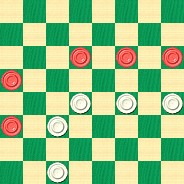
WHITE
White to Play, Black to Draw
W:W30,22,20,19,18:B21,13,12,11,10.
Material may be even, but there are significant mobility issues and things are not so simple. How can Black find the way to a draw?
When the drummer is Dunne Drummond, can you drum up the solution? Work it out and then drum your mouse on Read More to see the solution, along with detailed notes and numerous sample games.![]()
Man in the Middle

"Man in the middle" can have several meanings. In the computer security world, it refers to a cyberattack based on intercepting--- getting in the middle of--- a network path. In the baseball example shown above, the baserunner is caught between bases. In general, being "the man in the middle" isn't a very good thing.
Not so in today's checker problem, which is credited to old-time checkerist D. Robinson of Glasgow. Let's have a look.
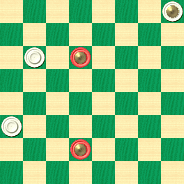
BLACK
Black to Play and Draw
B:WK29,24,12:BK23,K7.
Black has two men in the middle (actually, two kings). But the title of our problem is "man" in the middle, not "men." That's a bit of a hint toward finding a somewhat surprising draw for Black.
Can you solve it, or will you get caught in the middle? Click your mouse (the left button, not the middle one) on Read More when you're ready to check your solution.![]()
4th of July: The Sentinel

Every year we say that we love celebrating America's birthday, the Fourth of July, and this year is no different. At The Checker Maven we're proud to be patriots and with today's problem, we salute everyone who serves our nation, whether past, present, or future.
As we always do on this date, we turn to Tommie Wiswell, master checker problemist, champion player, and World War II veteran. He calls this problem "The Sentinel" and we think that title is an appropriate tribute to those serving us today as sentinels of freedom.
Here's the position.
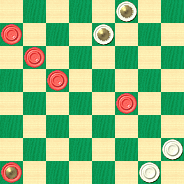
White to Play and Draw
W:W32,28,K7,K3:BK29,19,14,9,5.
The title gives a clue to the solution. Can you work it out, perhaps between hot dogs at the 4th of July picnic? Don't get cole slaw on your checkerboard! When you're ready, click on Read More to reveal the carefully guarded solution.![]()
The People's Journal

We've heard more than enough over the years about the "People's Republic of XXX" and the "Democratic People's Republic of YYY" and all the rest. These countries are seldom a republic and virtually never democratic.
So our latest finds, "The People's Journal" and "The People's Checker Book" might at first sound more than a little suspicious, until we point out that these publications date back to about 1898, long before the first appearance of a "People's Republic" and even before the Bolshevik revolution.
In fact, "The People's Journal" published some interesting checker problems, one of which is presented below.
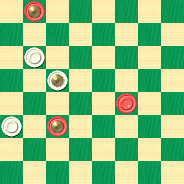
BLACK
Black to Play and Win
B:B14,K11,K22:W12,24,K19.
This problem has a surprisingly clever solution, and it might in fact fool some of the people some of the time, but we suspect it will please all of the people all the time. When you're ready to check your answer, it's your democratic privilege to click your mouse on Read More.![]()
June 18: A Nutty Day in History
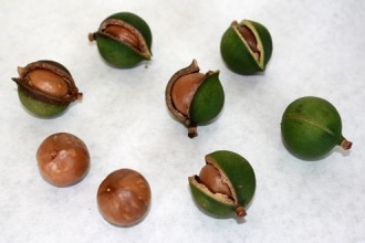
Today's column appears on June 18, 2016, and we found an interesting Hawaiian connection to this date, which lead to a rather tenuous checker connection. But first, a little background is in order.
You probably didn't know that the macadamia nut is named after Scotsman John Macadam, who was born in 1829, but if you've ever visited Hawai`i you'll be familiar with the flavor and texture of this iconic item.
The macadamia nut was first brought to Hawai`i in 1881 by William Herbert Purvis, but the reintroduction in 1892 is usually taken to be the beginning of commercial production. Brothers Edward Walter and Robert Alfred Jordan planted their trees on Wyllie Street in Nu`uanu Valley on, you guessed it, June 18 of that year. Upon reading the name "Robert Alfred Jordan" we immediately thought of the great checkerist Alfred Jordan, but of course that was another person altogether.
Still, we continued with that nutty line of thinking and tried to recall the "nuttiest" checker problems we've ever seen. In the end we decided on this one.
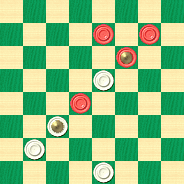
WHITE
White to Play and Win
W:W31,25,K22,15:B18,K11,8,7.
Why is this a "nutty" problem? Actually, it's a really good one, and White needs to find several "star" moves. It just struck us that the board position looks, well, nutty, and not something you're likely to see very often, if ever, in over the board play. Is the problem "nutty" or merely a "tough nut to crack"?
Don't go nuts; just work out the solution and then click on Read More to see the not so nutty solution.![]()
The Checker Maven is produced at editorial offices in Honolulu, Hawai`i, as a completely non-commercial public service from which no profit is obtained or sought. Original material is Copyright © 2004-2025 Avi Gobbler Publishing. Other material is public domain, as attributed, or licensed under Creative Commons. Information presented on this site is offered as-is, at no cost, and bears no express or implied warranty as to accuracy or usability. You agree that you use such information entirely at your own risk. No liabilities of any kind under any legal theory whatsoever are accepted. The Checker Maven is dedicated to the memory of Mr. Bob Newell, Sr.

